Class Of 1959
Sheltering Arms Hospital
Sheltering Arms
For those of us growing up near the Mississippi River, Sheltering Arms was a familiar sight, but a place we were never able to visit. Its uses changed over the years from an orphange for "homeless and destitute" children (1881 - 1942), then a hospital for children being treated for polio (1943 - 1954) and finally as a day school for "mentally retarded" children (1955 - 1982). Below the photos is an excerpt from a report on the school written in 1960 as they tried to design an appropriate program for the students.
As a Blue Bird, our group made tray favors for the children at the hospital. In particular, we created favors for all the holidays--Valentine's Day, Easter, Thanksgiving, and Christmas. One year, we decorated and varnished wooden trays for use by the children. Since the hospital was close to our home, my mother (our Blue Bird leader) would take our various projects to the staff at the hospital.
Upon closure of the school, Becketwood, a senior cooperative community, was built on the site, and the first residents moved into the apartments in 1986. The Chapel on the Becketwood grounds is the only remaining structure of the original Sheltering Arms facility.
Below is a postcard, dated 1948, and photos taken in 2018, showing the chapel, its entry gate, and memorabilia kept by the Becketwood personnel.
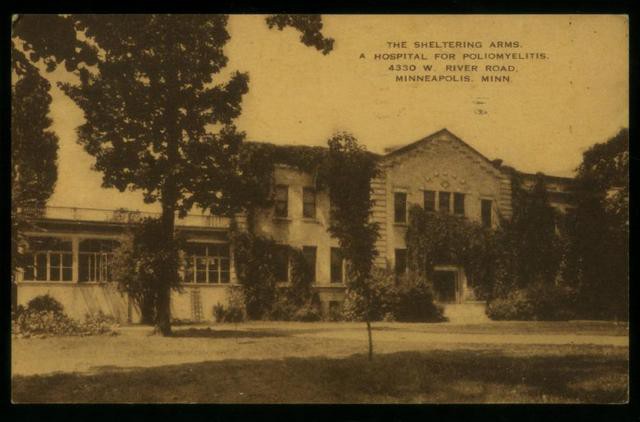
This postcard of the Sheltering Arms Hospital is dated 1948.
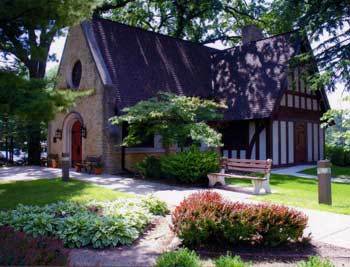
Sheltering Arms Chapel
.jpg)
Sheltering Arms Entry - 2018
.jpg)
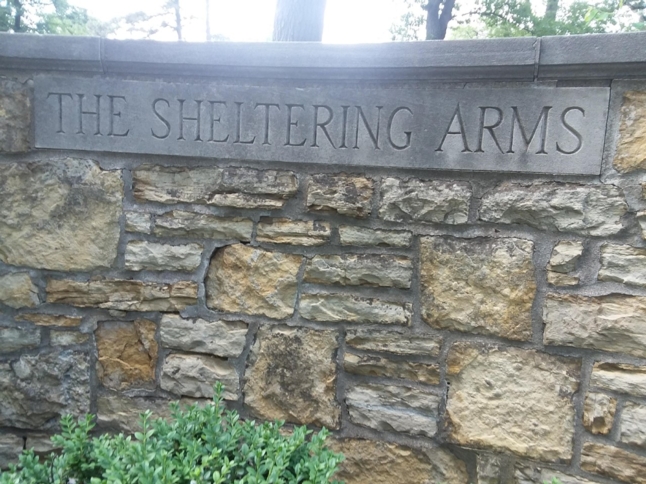
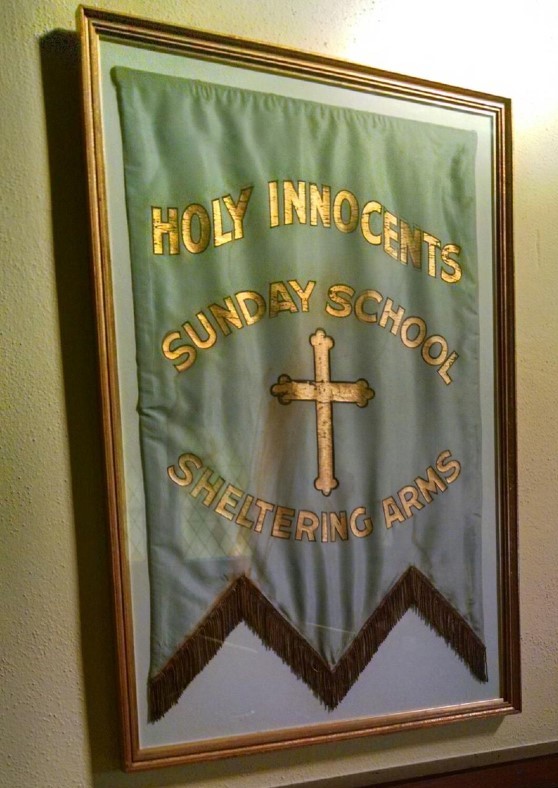
Original Banner from the Sheltering Arms Chapel--
Hanging in the Chapel in 2018.
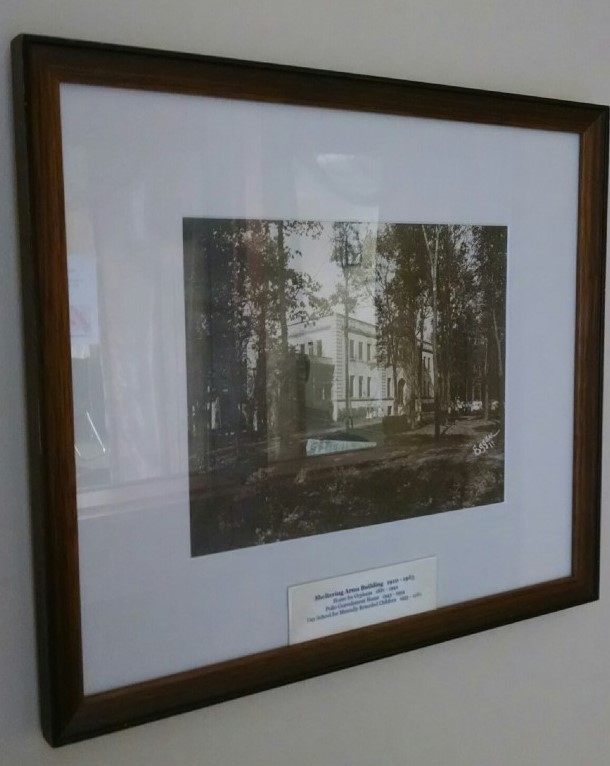
Photo of Original Hospital Hanging in Becketwood - 2018
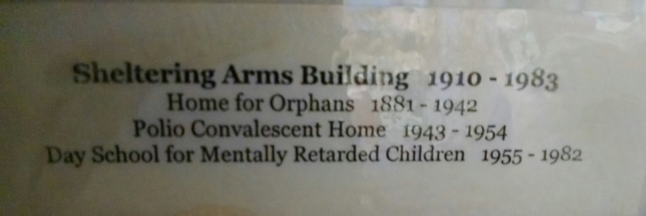
Photo from Photo Above - 2018
The following excerpt is from--note how the language used in talking about children with dsabilities from 1960 - 2018:
FIVE-YEAR REPORT OF THE SHELTERING ARMS, A DAY SCHOOL AND RESEARCH PROGRAM FOR MENTALLY RETARDED CHILDREN IN COOPERATION WITH THE MINNEAPOLIS PUBLIC SCHOOLS
SEPTEMBER, 1960
Prepared by: Harriet E. Blodgett, Ph. D., Program Director for The Sheltering Arms
INTRODUCTION
The Sheltering Arms was established in 1882 as a charitable organization to provide services to children. Incorporated as a nonprofit organization, it has been operated by a Board of Directors composed of thirty women, fifteen from Minneapolis and fifteen from St. Paul, under the auspices of the Episcopal Church.
Over the years, it has been supported by gifts and endowments and has served children without discrimination as to race, creed, or color. For many years - until 1942 - it was an orphanage for homeless and destitute children. From 1942 until 1955, its facilities were used as a hospital for the treatment of poliomyelitis.
In the winter of 1955, foreseeing the end of the need for the polio facilities, the Board of Directors sought the advice of the Community Welfare Council of Hennepin County as to local needs of children for which its buildings grounds and available financial support might wisely be used. The Council appointed a committee with broad Twin City professional competence which studied the problem for several months.
Under the chairmanship of Dr. Maynard Reynolds of the University of Minnesota, the committee recommended that The Sheltering Arms, in conjunction with the Minneapolis Public Schools, develop a day school for mentally retarded children to provide not only school facilities on a service basis for both trainable and educable ability levels but even more importantly, to attempt by means of a research approach to delineate more clearly the problems involved in the education of retarded children and to provide information as to solutions of these problems.
Attention was focused particularly on the pressing needs of the "trainable" ability level and questions related to the inclusion of this ability level within the framework of public school responsibilities. Attention was also to be given to the family living situations of mentally retarded children, in terms of family adjustments, special problems created or magnified by children's intellectual handicaps, counseling content and techniques, and problems of long range planning.
Dr. Maynard Reynolds, in a letter to Mr. John Gregg, the business administrator of The Sheltering Arms, summarized the general principles emerging from the work of the Community Welfare Council committee as follows:
1. That the program should be comprehensive in scope and truly of "optimum type," drawing upon the knowledge and skills of all disciplines having concern with problems of mental deficiency.
2. That the programs not duplicate any existing facility. Although functions might, in some respects, overlap with those of available facilities in order that research and demonstration aspects of the program be replicable in other settings, the program should not be planned primarily in terms of "service" or as an extension of existing facilities.
3. That research, diagnostic and professional training functions is given primary place in the program. It is in this way that the uniqueness of the facility is most clearly established. There is already promise of cooperation and assistance by University personnel in these regards.
4. That there be a core service program for retarded children which, though justified in and for itself, will provide the population and ongoing activity program through which more far-reaching purposes can be realized. And further, that recognition is given to the problems of parents and siblings of retarded children through the development of family consultation services - again on a research basis.
5. That the program be planned for populations and in terms of problems with which there is likely to be long range concern. This is to say that we recommend against development of a program in terms of "emergency" type problems, although flexibility in population selection and programming would of course be required even for research purposes.
6. That although sponsored by a private agency, the project be, from the beginning, a cooperative one with various public agencies of the region. Schools, colleges, the University, community and state welfare agencies, parent associations, and professional societies are seen as closely involved. Through careful studies of Individuals and experimental programming, it is anticipated that The Sheltering Arms program would become a focal center from which many agencies might draw a clearer purpose and more adequately defined program."
Specific recommendations of the planning committee were:
1. Establishment of three-day training classes, two of them of Group II type, and one of Group I type as defined by State Board of Education standards and regulations.
2. Establishment of a diagnostic clinical service for children admitted to training classes.
3. Establishment of diagnostic clinical services for children not admitted to training classes (those too young, too old, for other reasons not eligible for, or admitted to, the training classes.)
It is the purpose of this five-year report to review the development of The Sheltering Arms Day School and Research Program for Mentally Retarded Children; to report the educational and service aspects of the program; to describe the directions research has taken, and report the results: to describe the diagnostic program, the family counseling program, and the community education program; to indicate the quantity and scope of research stimulated by the existence of this program; to describe the professional training functions fulfilled by the school; and to make recommendations to the Board of Education of the Minneapolis Public Schools with regard to planning educational procedures for mentally retarded children.
As the partnership between the Minneapolis Public Schools and The Sheltering Arms was worked out, the schools provided the classroom teachers, transportation, consultative services and the regular special education budget for classroom equipment and supplies. The Sheltering Arms provided the building, grounds, maintenance, and all the remaining staff, professional and non-professional. The only part of the cost carried by families was the cost of the school lunch - currently $.35 per day per child. Transportation was facilitated by the fortuitous location of The Sheltering Arms property within a few blocks of Dowling School, the Minneapolis Public School for physically handicapped children. Since these children come from all sections of the city, as do mentally retarded children, it was possible to arrange that The Sheltering Arms retarded children be transported by the Dowling School bus service. Without this "good luck" feature, the practical problems of transportation would have been much more difficult to solve.
During the first year, 1955-56, three classes were provided for the six to ten-year age range: two for trainable children, and one for educable children, with ten children in each trainable class and fifteen (sometimes sixteen) in the educable class.
The following year, a class for older trainable children, aged eleven to fourteen, was added; at the beginning of the fourth year, a class for older educable children, aged eleven to fourteen, was added.
At the present time, services are provided for about fifty-six to fifty-eight children, in five classes. The staff involved in this program has included the following: three to five teachers depending on the number of classes in operation, provided by the Minneapolis Public Schools but with some selection and choice by The Sheltering Arms' staff; consultative services in special education, speech, medicine, nursing safety, recreation, and diagnosis; a program director, business administrator, psychological research assistant, and social worker provided by The Sheltering Arms, which has also provided the rest of the staff - bookkeeper, secretary, part-time medical consultant, part-time chaplain (who also served as recreational assistant for three of the five years), one to three paid classroom assistants, depending on the number of classes; and the building staff - cook, assistant cook, dining room assistant, housekeeper, janitor, and sometimes an assistant janitor. In addition, a volunteer program has been of inestimable value in providing optimum supervision and additional practical help to teachers and staff.